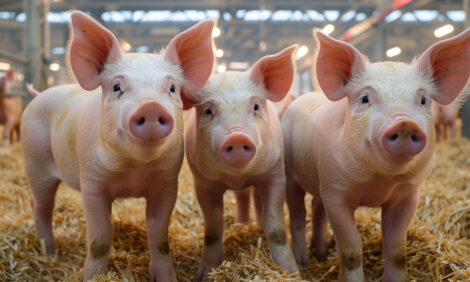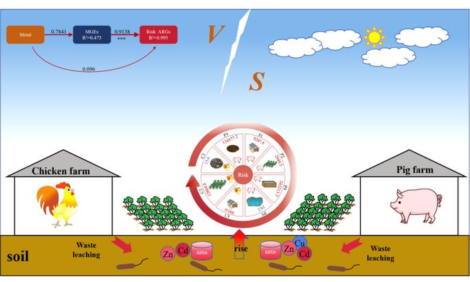



Micro-Organisms as Feed Additives - Probiotics
By Ortwin Simon and presented at the 2005 Banff Pork Seminar - For many decades antibiotics (so called growth promoters) have been used as feed additives in various species of farm animals, to reduce the frequency of diarrhoea under certain conditions. |
Introduction
Furthermore, in most cases performance
parameters like body weight gain or feed conversion ratio improves to up to
5%. These beneficial effects of feed antibiotics are generally explained by
modifications of the intestinal bacteria and their interaction with the host animal,
including bacterial interactions with intestinal tissue (turnover of epithelial cells,
surface coating – formation and secretion of mucins, cell invasion and resulting
lesions) as well as the immune system (response of the lymphocyte population
and formation and secretion of immune globulins). Thus, the intestinal
microbiota is not only involved in nutrient conversion along the gastrointestinal
tract, but may also affect or support animal health.
Because of the concern that the use of antibiotics as feed additive might
contribute to an increase of bacterial antibiotic resistance, the European Union
(EU) has decided to ban antibiotics as feed additives from 1st January 2006
onwards. Therefore, many activities were initiated to establish other substances
with beneficial effects on animals via modifications of the intestinal microbiota.
Among these so called “alternatives to antibiotics” are probiotics, prebiotics,
organic acids and herbs, as well as essential oils.
The Use Of Microorganisms In Human And Animal Nutrition
Microbial Origin And Application
The concept of probiotics goes back to Elie Mechnikoff who proposed almost
100 years ago that bacteria in fermented milk products may be capable to
control bacterial fermentation in the intestinal tract of men and thus are health
promoting. Today, yoghurts containing living probiotic bacteria are available for
the consumer. Bacteria with the highest potential to support human health are
believed to be Lactobacillus and Bifidobacterium species.
Especially during the last decade, the concept of probiotics has been applied in
animal nutrition as well. However, the use of micro-organisms in feed differs
considerably from that in human food (Table 1). Out of 21 probiotic
preparations actually authorised for the use as feed additives in the EU 13 are
approved for the use in piglets and only some of them in feed for sows and
fattening pigs. Seven of these preparations are selected strains of
Enterococcus faecium (natural habitat: digestive tract), two contain spores of
the bacterial genus Bacillus (natural habitat: soil), two are strains of the
Saccharomyces cerevisiae yeast (natural habitat: fruits) and only one product
contains Lactobacillus farciminis and Pediococcus acidilactici, which habitat is
the digestive tract and milk products, respectively. The recommended
concentration for most probiotics is approximately 109 colony forming units per
kg of feed.

This has some implications for the comparison of human and animal probiotics:
- Micro-organisms used as feed additives are of different microbial origin.
- The majority of authorised probiotics are approved for the use in piglets feed.
- Most probiotics for piglets are selected strains of Enterococcus faecium.
Required Properties Of Micro-Organisms For In Feed Application
Most commonly, probiotics are defined as viable micro-organisms which, after
sufficient oral intake, lead to beneficial effects for the host by modifying the
intestinal microbiota. Thus, the probiotic strain must reach the intestine in a
viable form and in sufficient numbers. This requires the survival of the probiotic
during feed processing, including pelleting by heat in many applications, its
stability in feed storage over weeks and finally its safe passage through the
adverse low pH conditions in the stomach. The reason for the minor role of
lactobacilli and bifidobacteria as feed additives is their poor stability during feed
processing and storage. The by far most stable probiotic strains are Bacillus
spores, because their spores are heat resistant and stay viable during longterm
storage. For instance, the recovery of Bacillus cereus toyoi after pelleting
at 87°C was 95 % and after 8 weeks in feed storage was 92 %. Vegetative,
dehydrated cells like E. faecium are more sensitive to heat treatment (Figure 1)
and inactivation during storage for 8 weeks is approximately 50 %.
probiotic after pelleting at various temperatures
(Temperature measured in the conditioner)

By means of confection (absoption into globuli, coating) vegetative cells can be stabilized to some extent. Once the percentage loss of viability is known it can be compensated for by overdosing the initial concentrations. It is relatively easy to assess the above mentioned stability parameters. It is much more difficult to identify viable non-sporing probiotic bacteria in the intestinal tract. Especially intestinal bacteria as Enterococci or lactobacilli cannot be distinguished on the strain level with routine microbiological methods. However, with some probiotic strains this can be achieved by specific RNA or DNA probes, as will be demonstrated later.
Effectiveness and Mode of Action of Probiotics
Effectiveness
Since probiotics are discussed as alternatives to growth promoters one should
suppose they will promote animal performance. As summarized from several
published experiments (Figure 2) this seems to be true as a trend for the
majority of published experiments, however, the improvements were only
significant in some feeding trials. This points towards a high variation in the
response of the individual animals to this type of feed additive. It should be kept
in mind that probiotics do not act like essential nutrients. There is no dose
response, but rather a threshold level. Probiotics act mainly via modifications of
intestinal bacterial populations and their effectiveness depends on the microbial
status of a flock of animals and of the individual animal. Therefore, high
variabilities of the effects are understandable.
Diarrhoea is the main problem for piglets during the first weeks after weaning
and consequently reduction of the incidence of diarrhoea by probiotics has
been studied most frequently. Published data on this aspect indicate that in
approximately 80 % of the experiments a significant incidence of diarrhoea was
observed in piglets receiving probiotics. This effect was independent of the type
of micro-organism (B. cereus, E. faecium, P. acidilactici). This agrees well with
our experience at our experimental station, where in 3 separate studies with
piglets (two with E. faecium NCIMB 10415, one with B. cereus toyoi) a
significantly reduced incidence of diarrhoea was recorded, but effects on
growth performance were not significant. The described situation above would
at least imply less required veterinary interventions, which may be cost-saving
for the producer and therefore a further aspect of efficacy.
on weight gain and feed conversion in piglets
(evaluations of 22 publications)

Mode of Action of Probiotics
Having in mind the use of micro-organisms of different origin with similar
beneficial effects, it seems logical that their modes of action will probably be
based on more than one principle. However, the modification of the microbial
population seems to be the prime mode of action. The interaction between the
probiotic strain and the intestinal microbiota may be based on aggregation with
pathogenic bacteria, competitive adhesion to epithelial receptors, production of
specific substances (organic acids, bacteriocins, dipicolinic acid), or competition
for nutrients. As probably secondary effects, (primary effects of some probiotics
seem also to exist) modifications of the structure and function of the intestinal
epithelium as well as of the immune response were described. Although, in
both fields, human and animal nutrition, great efforts have been made to study
the mode of action of probiotics, our knowledge based on hard experimental
data is still rather limited. The situation with regard to human nutrition was
recently characterized in Nature (Abbott, 2004) as follows “…even when
probiotics seem to work…..we know too little about the normal gut ecosystem
to understand why”.
Within an interdisciplinary research group, including animal nutrition,
microbiology, transport physiology, morphometry/histology and immunology
(Project sponsored by the German Research Foundation) we have tried to
study the effects of one probiotic strain (E. faecium NCIMB 10415) on various
parameters. In this project the probiotic was fed to the sows during gestation
and lactation and to piglets during the suckling period with creep feed and after
weaning at day 28 for 6 weeks. Control animals received the same
unsupplemented diets.
The results (effects of the probiotic treatment) of theis integrative study can be
summarised as follows:
Performance of sows and piglets was not influenced significantly.
Incidence of diarrhoea was reduced significantly after weaning.
Precaecal digestibility of amino acids was significantly increased.
No structural modifications of the epithelial tissues were observed by means of morphometry.
Transepithelial movement of glucose in the small intestine was stimulated.
The probiotic strain was found in the intestinal tract of piglets before offering creep feed, i.e. transfer from sow to piglet occurred.
Bacterial communities of sows and piglets are modified and less diverse compared to controls.
Decline of frequency of ß-haemolytic and O 141 serovars of E. coli but not of total coliform bacteria in colon content of piglets.
Significantly reduced level of cytotoxic T-cells (CD8+) in the jejunal epithelium of piglets.
Conclusions
From these results it may be concluded that the studied strain modifies the microbiota of sows and piglets with beneficial effects for the host animal, which were in the present experiment not reflected in the animals performance. Secondary or direct functions of epithelial tissues and immunological parameters were modified by the probiotic. Therefore, probiotics must be considered as an potential element in a feeding and management system of pig production without the use of antibiotic feed additives. Whether or not these finding on the mode of action of E. faecium NCIMB 10415 can be applied to other micro-organisms has to be proved in further studies.
Reference
Abbott, A. (2004) Gut reaction. Nature 427: 284-286
To view the full Banff Pork Listing, click here
Source: Paper presented during the 2005 Banff Pork Seminar Procedings









